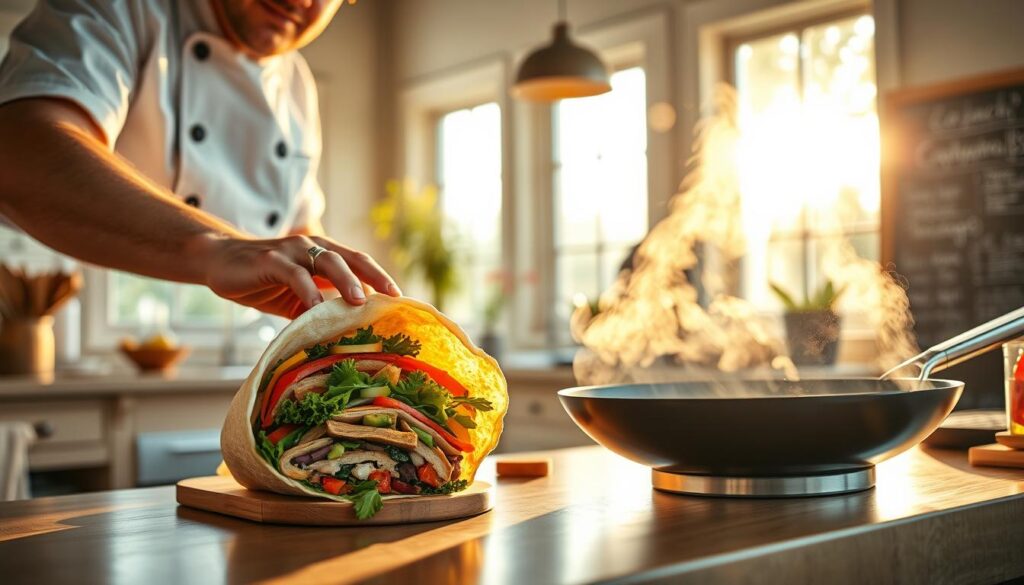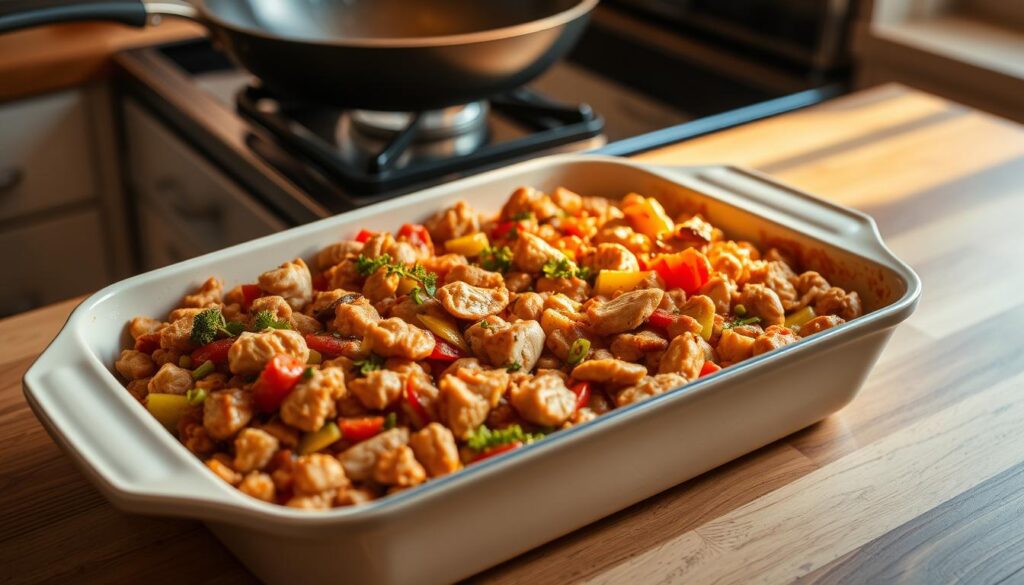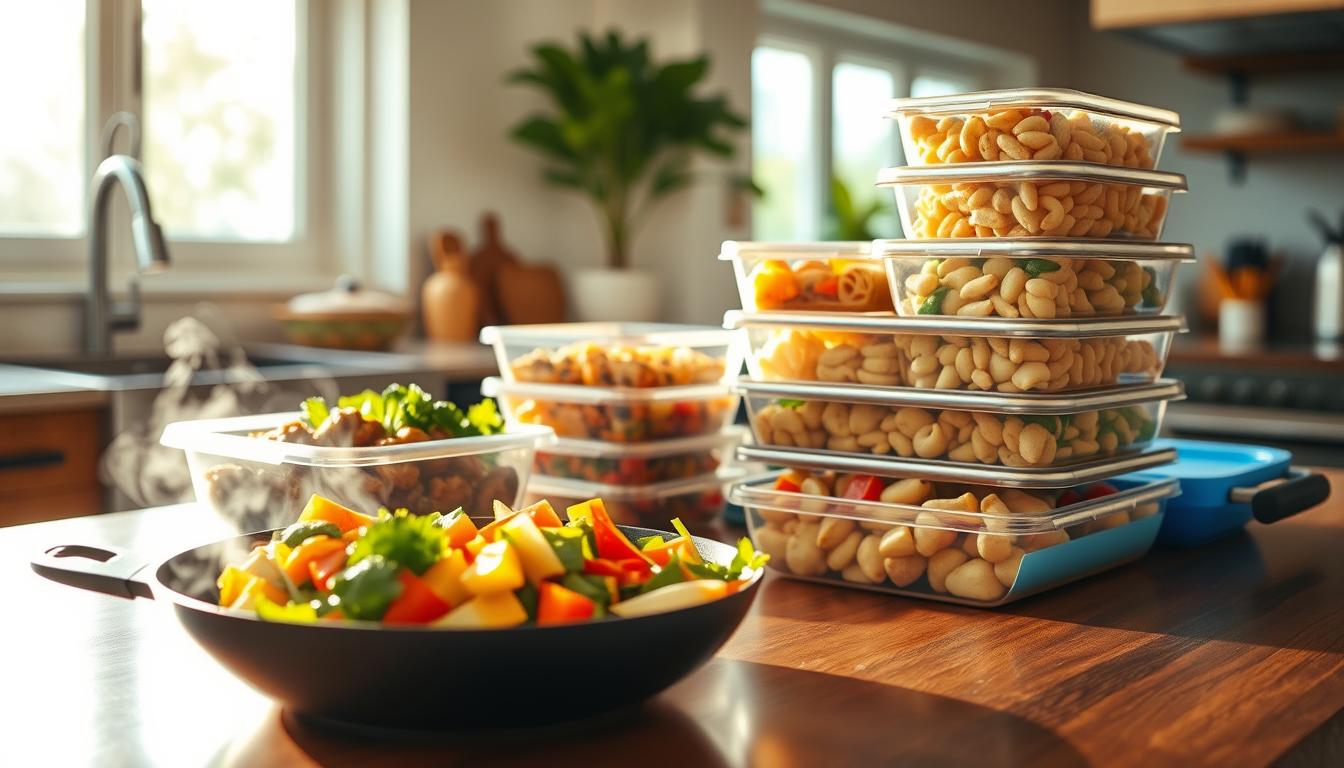After cooking a meal, we often have leftover ingredients. It can be hard to think of new ways to use them. But, with a bit of creativity, we can turn last night’s dinner into a tasty lunch. The National Resources Defense Council says up to 40% of food in the U.S. goes uneaten.
By using leftovers, we can cut down on waste and make delicious meals. We can explore different recipes and cooking methods to save money and reduce waste.
Leftover buttermilk, chicken stock, or egg yolks can make new dishes like Dark Chocolate Pudding. Marinara and tomato-based sauces can be made in bulk and frozen, perfect for lunch. This way, we can stretch one dinner into two, saving time and money.
About 34% of leftover meals become new dishes, showing their versatility. Around 52% of people want recipes that use leftovers to reduce waste. By using leftovers in meal prep, we can save $10 per meal and cut down on bread waste by up to 20%.
Key Takeaways
- Using leftovers can minimize food waste and create delicious new meals
- Creative cooking techniques can help reduce waste and save money
- Kitchen organization is a significant factor in effectively using leftovers
- Approximately 34% of leftover meals result in the creation of new dishes
- Incorporating leftovers into meal prep can save an average of $10 per meal per household
- Leftover recipes and creative cooking can help achieve a balanced diet without food spoilage
Introduction to Leftovers and Creativity
Using leftovers is a smart way to cut down on anti-food waste and make new meals. A survey found that nearly half of Americans didn’t know they had leftovers in their fridge. By using leftovers, we can avoid this and come up with fresh leftover lunch ideas.
Cooking helps reduce food waste by using up extra ingredients. For instance, a roast chicken can give you leftovers for 2-3 days after the first meal. Also, having 1-2 ‘leftovers’ nights a week can cut down on waste and save money and time.
The Benefits of Using Leftovers
Using leftovers has many advantages, like cutting down on food waste and saving money. It’s estimated that household food waste costs the average American family about $1,500 a year. By using leftovers, families can cut their food waste by 25% and save up to 20% on grocery bills.
How Cooking Can Minimize Food Waste
Cooking can help reduce food waste by using up extra ingredients and making new meals. Here are some ways to do this:
- Cooking bigger portions to reuse them
- Adding leftover proteins to salads
- Turning leftover pasta into baked dishes
| Food Item | Shelf Life |
|---|---|
| Leftover Rice | 4 days |
| Leftover Fruits and Vegetables | Varies |
Breakfast Transformations
Turning last night’s dinner into a tasty breakfast is a smart move. It helps us reduce food waste and get creative. We can make omelets and smoothies with leftover ingredients. For instance, leftover veggies can make a tasty omelet, and leftover fruits can blend into a healthy smoothie.
Some creative recipes for breakfast include turning dinner into omelets. We can also make smoothies with leftover fruits and veggies. And, we can create breakfast porridge with leftover whole grains. These recipes are not only good for the planet but also make a nutritious and filling breakfast.
Turning Dinner into Omelets
Omelets are a fantastic way to use up leftover dinner ingredients. We can add veggies, meats, and cheeses to an omelet filled with eggs. Then, we cook it until the eggs are set. This method is quick, easy, and delicious, all thanks to anti-waste cooking.
Smoothies with Leftover Fruits and Veggies
Smoothies are another excellent way to use up leftover fruits and veggies. We can blend them with yogurt and milk for a healthy breakfast smoothie. This is a great way to enjoy our daily fruits and veggies while reducing food waste.
By being creative with leftovers, we can make many delicious breakfast dishes. From omelets to smoothies, these creative recipes are not only good for the planet. They also give us a nutritious and filling breakfast to start our day.
Salads Reimagined
Salads are a great choice for lunch ideas. By adding grains and proteins, we can make them more nutritious. For instance, quinoa or leftover roasted veggies can turn a simple salad into a healthy meal.
Here are some ways to make salads more exciting:
- Adding grains like quinoa, brown rice, or farro to increase the nutritional value
- Incorporating proteins like chicken, salmon, or tofu to boost the protein content
- Using leftover roasted vegetables like sweet potatoes, Brussels sprouts, or cauliflower to add flavor and texture
Being creative with leftover recipes can lead to amazing salads. It’s a fantastic way to reduce waste and try new things. So, next time you’re looking for a tasty lunch idea, think about reimagining your salad.
Wraps and Sandwiches
Using leftover proteins to make unique spreads and sauces can take your wraps and sandwiches to the next level. This method not only cuts down on food waste but also opens up a world of flavors and textures. It’s a great way to help the environment while enjoying tasty meals.
For example, you can turn leftover chicken into a delicious chicken salad. Or, use leftover turkey to make a mouthwatering turkey sandwich. These ideas help reduce the 40% of food that’s thrown away in the U.S. By getting creative with leftovers, we can eat healthy and make a difference.
Here are some tips for using leftover proteins in unique spreads and sauces:
- Use leftover chicken to make a delicious chicken salad with your favorite herbs and spices.
- Make a tasty turkey sandwich with leftover turkey, avocado, and bacon.
- Get creative with your sauces by using leftover vegetables to make a homemade mayo or mustard.

By adopting these creative cooking techniques and anti-food waste practices, we can make a big difference. We can reduce food waste and promote sustainability in our kitchens.
Soups and Stews
Soups and stews are great for using leftover vegetables. We can make creamy soups by blending them. Adding grains makes stews hearty. This way of cooking is tasty and helps reduce kitchen waste.
Using leftover recipes has many benefits. It cuts down on food waste, saves money, and adds variety to meals. For instance, turning leftovers into new dishes can save a family of four up to $1,500 a year, the USDA says. Broth and extra ingredients can also make soups taste better, using 20-30% of leftovers.
Blending Leftover Vegetables for Creamy Soups
- Use a mix of leftover veggies like carrots, potatoes, and onions for a tasty soup.
- Add broth and cream for a creamy texture.
- Blend until smooth and serve hot, topped with fresh herbs.
Adding Grains for Hearty Stews
Adding grains like quinoa or brown rice to stews makes them more filling and nutritious. Grains also offer:
- More fiber
- More protein
- Better texture and taste
By using leftover recipes, we can cut down on waste, save money, and enjoy tasty meals. So, next time you have leftover veggies, try making a creamy soup or hearty stew. Enjoy the benefits of anti-waste cooking.
| Benefits of Using Leftover Recipes | Description |
|---|---|
| Reduces Food Waste | Using leftover recipes can help reduce the amount of food waste in our kitchens. |
| Saves Money | Transforming leftovers into new dishes can help save up to $1,500 per year for a family of four. |
| Increases Meal Variety | Using leftover recipes can help increase meal variety and reduce food boredom. |
Pasta Night: Reinvented
Reinventing pasta night can be a fun and creative way to reduce food waste and enjoy a delicious meal. By using leftover ingredients, we can create new and exciting dishes. For example, we can make a delicious pasta salad with leftover vegetables or mix leftover ingredients to make a tasty baked pasta dish.
Some creative recipes for pasta night include making pasta salad wraps. These can be filled with leftover pasta, vegetables, and cheese. We can also make a hearty and comforting baked pasta dish, perfect for a cold winter’s night. These lunch ideas are not only delicious but also help reduce food waste and save money.
- Use leftover ingredients to create new and exciting dishes
- Experiment with different combinations of ingredients to find your favorite
- Consider using leftover pasta to make a pasta salad or baked pasta dish
By following these tips and using a little creativity, we can reinvent pasta night. We can enjoy a delicious and satisfying meal while reducing food waste and saving money. With practice, we can come up with many creative recipes and lunch ideas for any occasion.
| Dish | Ingredients | Instructions |
|---|---|---|
| Pasta Salad | Leftover pasta, vegetables, cheese | Mix all ingredients together and serve |
| Baked Pasta | Leftover pasta, sauce, cheese | Mix all ingredients together and bake until golden brown |
Rice and Grains: New Life
Using leftover rice and grains is a great way to cut down on food waste. It helps us create new, tasty dishes. For example, fried rice is a hit that uses leftover rice. It’s also a good way to use up leftover veggies and proteins.
Leftover rice can be turned into many dishes. From fried rice to grain bowls, the options are endless. Here are some ideas to get you started:
- Fried rice with unique flavor combinations, such as kimchi or chicken
- Grain bowls with leftover proteins, such as chicken or tofu
- Rice pudding, a delicious dessert made with leftover rice
There are many ways to use leftover rice and grains. By being creative with leftovers, we can help the environment. So, next time you have leftover rice or grains, don’t toss them. Get creative and make something new!
| Recipe Idea | Ingredients | Cooking Time |
|---|---|---|
| Fried Rice | Leftover rice, vegetables, proteins | 15-20 minutes |
| Grain Bowls | Leftover grains, proteins, vegetables | 10-15 minutes |
| Rice Pudding | Leftover rice, milk, sugar | 20-25 minutes |
Innovative Casseroles
By using creative cooking and anti-waste cooking methods, we can cut down on food waste. We can make tasty meals by combining leftovers in one dish. This not only saves food but also saves time and money.
Some benefits of making casseroles include:
- Reduced food waste: Casseroles can use up to 50% of leftovers, minimizing the amount of food that ends up in landfills.
- Time-saving: Casseroles can be prepared in advance and cooked in under 30 minutes, making them a convenient option for busy households.
- Creative expression: Casseroles offer endless possibilities for creative cooking, allowing us to experiment with different ingredients and flavors.
To get started with making innovative casseroles, consider the following tips:

By following these tips and embracing anti-waste cooking practices, we can create delicious and sustainable meals. These meals reduce food waste and encourage creative cooking.
Snack Ideas from Leftovers
Turning leftovers into tasty snacks is a smart way to cut down on waste and get creative. It saves time and money, and you get to enjoy yummy meals. In the U.S., about 40% of food is thrown away, showing how using leftovers can make a big difference.
Using leftovers can also save you money. A study found that making meals from leftovers can cut food waste by 25%. It can also save up to 25% on grocery bills. Plus, cooking in bulk can cut down cooking time by up to 50%.
Tasty Croquettes and Fritters
Croquettes and fritters are fantastic snack ideas made from leftovers. You can mix leftover veggies, proteins, or grains to make them. For instance, leftover chicken can be turned into chicken croquettes, or leftover veggies can be made into vegetable fritters.
Creative Dips Using Leftover Ingredients
Creative dips are another excellent way to use leftovers. You can mix leftover veggies, proteins, or grains to make tasty dips. Here are some ideas:
- Spinach and artichoke dip with leftover spinach and artichoke hearts
- Hummus with leftover chickpeas and veggies
- Guacamole with leftover avocados
Freezing Leftovers for Future Meals
Freezing leftovers is a great way to cut down on food waste and save time. It helps us reduce our environmental impact. Plus, it lets us get creative with our meals.
When freezing leftovers, there are key steps to follow. Use freezer-grade products to keep air out and prevent freezer burn. Freezing in smaller portions can also speed up the process and reduce thawing needs.
Some foods freeze well, like soups, stews, and casseroles. But, cream sauces, custards, and high water content veggies don’t freeze as well. Knowing which foods freeze best helps us store leftovers wisely.
To start freezing leftovers, you need the right tools and knowledge. The FDA and the National Center for Home Food Preservation offer detailed guides. These guides include charts and FAQs to help you freeze food safely and creatively.
Here are some tips for freezing leftovers:
- Label and date frozen foods to use them safely
- Freeze individual portions for easy reheating
- Use airtight containers to avoid freezer burn
- Thaw in the fridge to keep food at a safe temperature
Eco-Friendly Practices in Cooking
Cooking has a big impact on our planet. By using eco-friendly cooking methods, we can lessen our harm. The Wisconsin Department of Natural Resources says food waste is a big problem.
Importance of Sustainable Cooking
Sustainable cooking helps the planet and saves money. It reduces waste and saves about $1,500 a year. Using leftovers and composting are key steps.
How Leftovers Contribute to Sustainability
Leftovers are vital for eco-friendly cooking. They help us waste less food. For instance, vegetable scraps make great broth. Leftover coffee can be used in cakes and marinades.
- Use leftover ingredients in new meals to reduce food waste.
- Compost food waste to minimize landfill waste.
- Adopt creative recipes that utilize leftover ingredients.
Eco-friendly cooking is good for the planet and tasty. Every little bit helps. Start with sustainable cooking to make a difference.
Conclusion: Embracing Leftovers in Lunchtime Meals
Using leftover recipes in our lunch can open up a world of creativity and sustainability. Instead of throwing away food, we can make new, tasty dishes. This approach lets us get creative and even host fun cooking parties.
Planning meals with leftovers can really help. It reduces waste, saves time and money, and promotes healthy eating. Families who use leftovers can cut their food costs by up to 25% each year.
So, let’s start using leftovers to explore new flavors. With a bit of creativity and a willingness to try new things, our kitchens can become places of delicious, sustainable meals. Let’s get creative and enjoy every bite!

